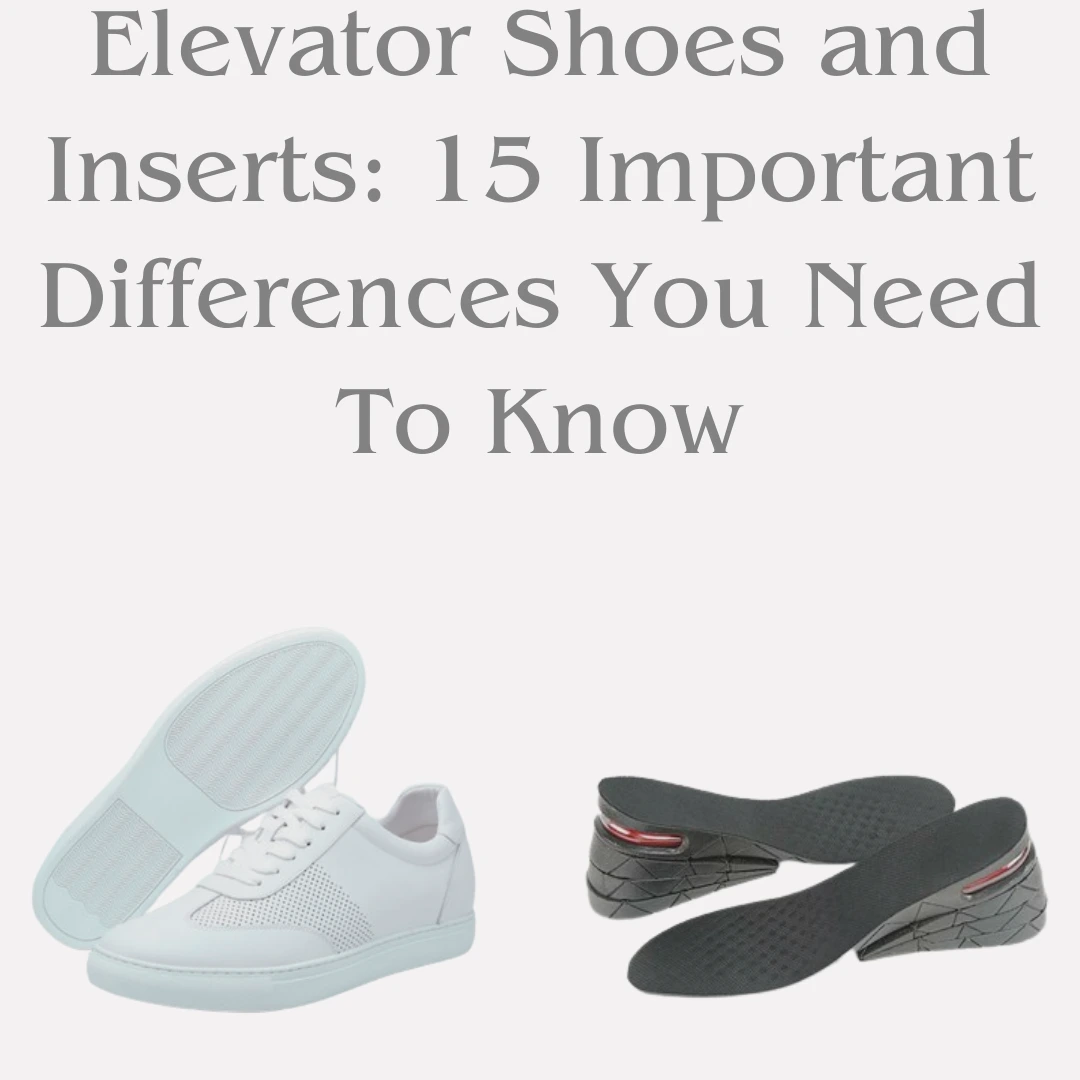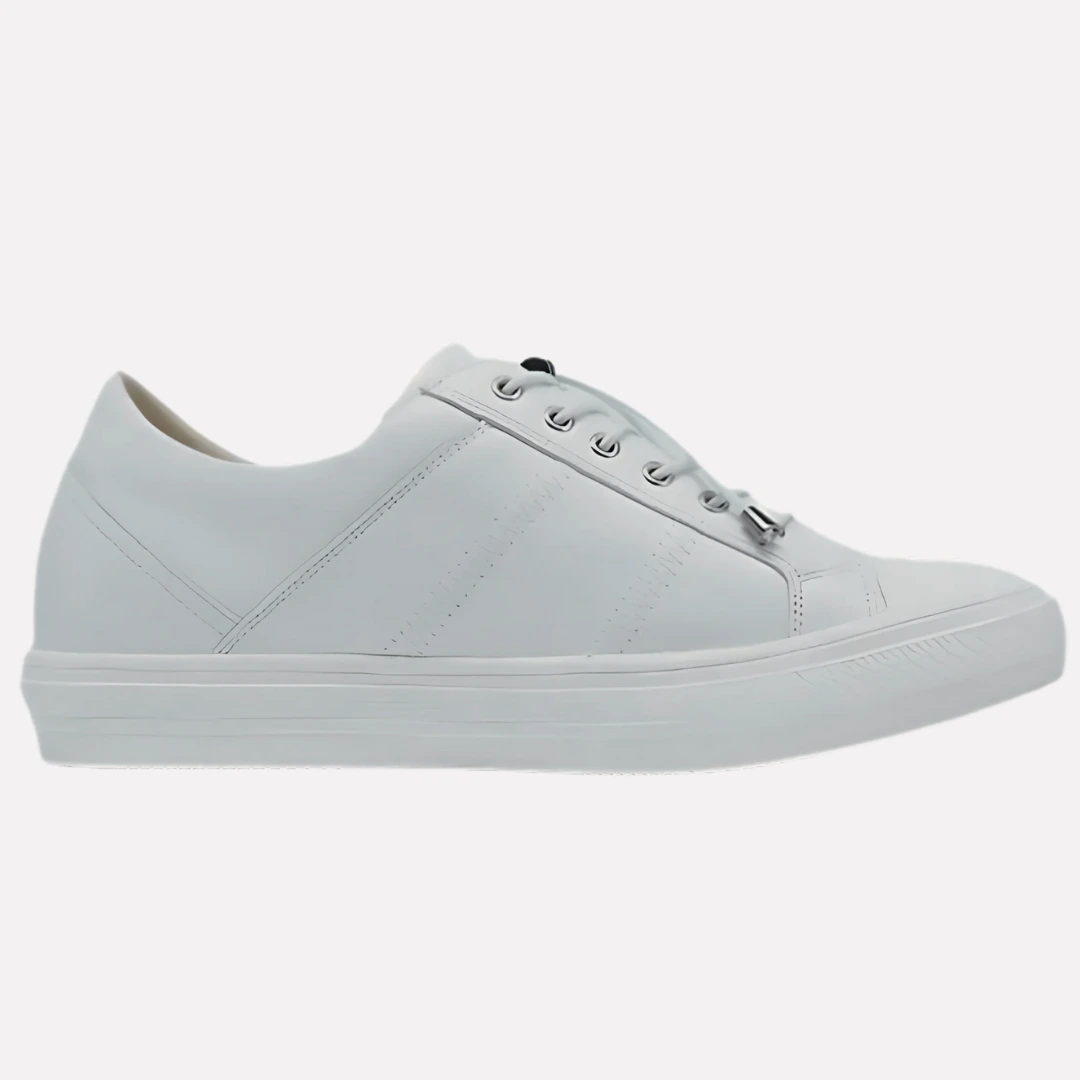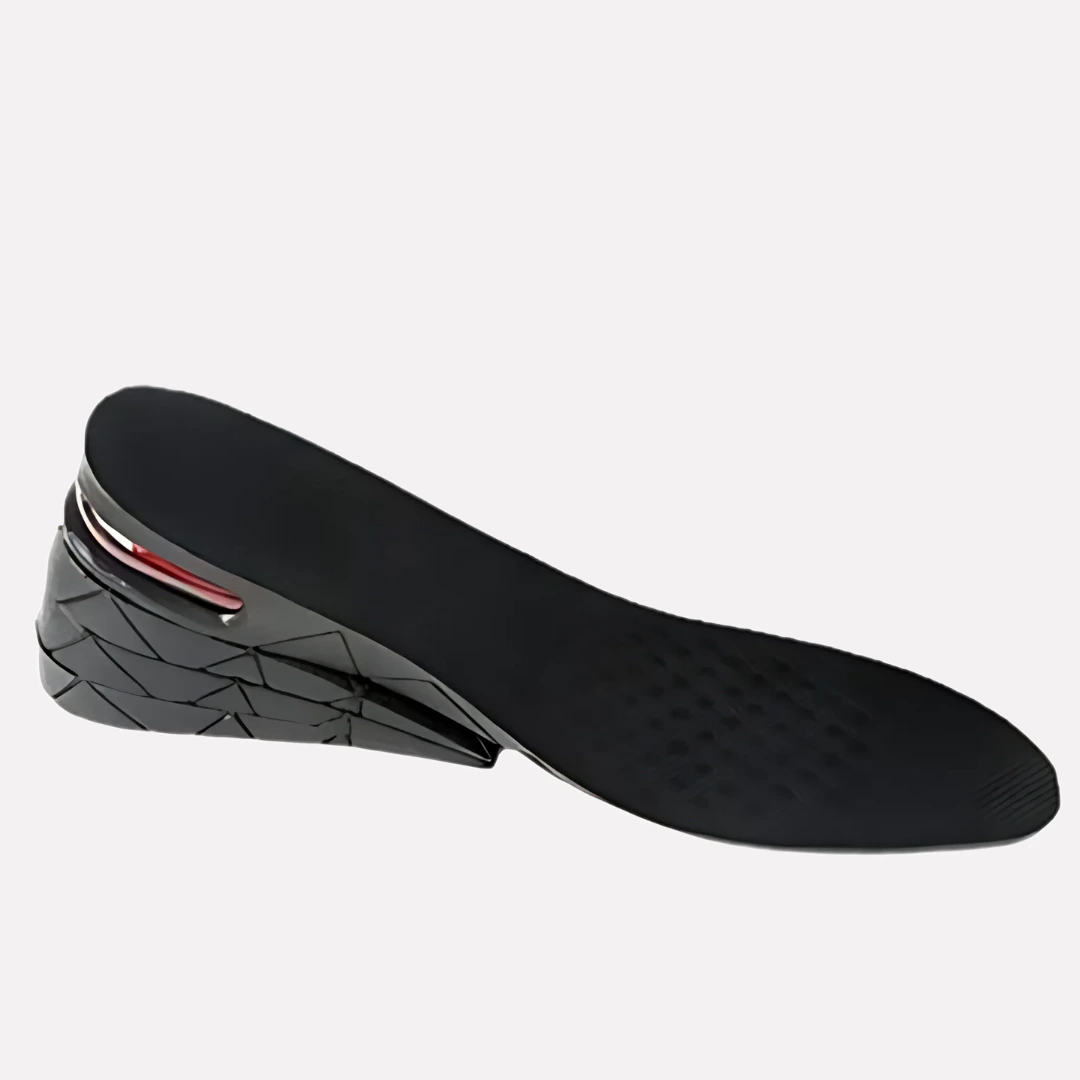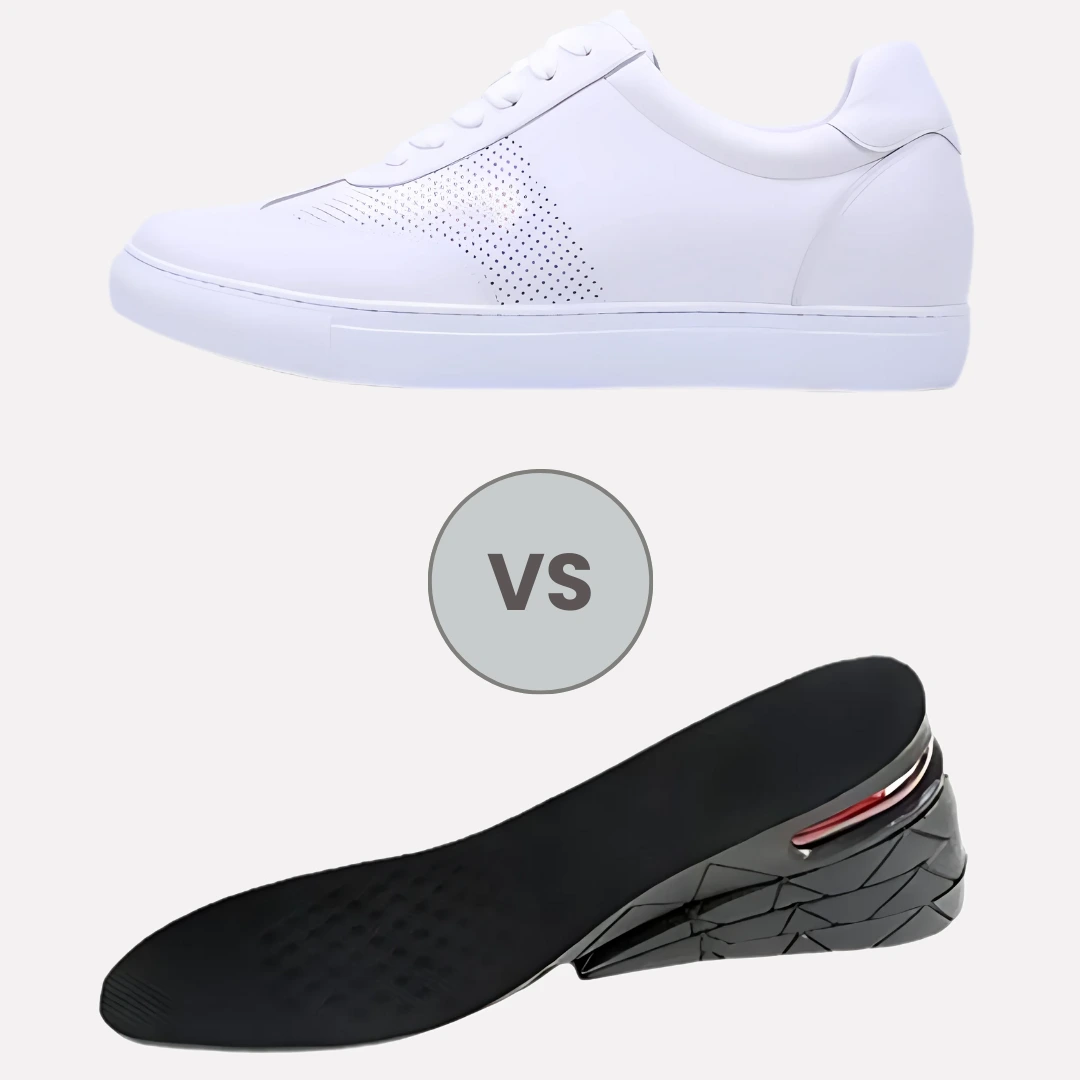
Short answer: The main difference between elevator shoes and inserts.
Elevator Shoes and Inserts have so much and common but what differs is that elevator shoes have a built-in heel or elevated insole designed to add height discreetly. They are constructed to include the height-increasing feature as part of the shoe’s design. Inserts, on the other hand, are separate, removable pads that can be added to any shoe to boost height. Inserts are versatile and can be used with different shoes, while elevator shoes are designed explicitly with height increase in mind. Elevator shoes are more comfortable since the shoe lift is fixed and does not move inside the shoe. In addition to that, an oversized insert will make it hard to fit your foot in. But that is not all; our verdict is that inserts stand nowhere close to the elevator shoes in terms of comfort, durability, or even height increase. As a matter of fact, we suggest avoiding inserts at all costs if you are worrying about your feet’ health and overall long-term durability. If you want a more in-depth answer, read on.
What Are Elevator Shoes?
Elevator shoes are specially designed footwear with built-in elevated insoles that add extra height discreetly. They look like regular shoes from the outside but have a hidden layer inside that raises the wearer’s height. This design is meant to improve posture, boost confidence, and enhance overall appearance without drawing attention to the height increase. Elevator shoes come in various styles, including dress shoes, casual shoes, and boots, making them versatile for different occasions. They are a popular choice for those who want to appear taller without the need for external height aids.

What Are Inserts?
Inserts are removable pads or cushions that can be placed inside any shoe to provide additional height or comfort. They come in various forms, such as foam, gel, or air-filled, and can be added to different types of footwear. Inserts can help with height enhancement, improve arch support, or offer extra cushioning. They are a flexible and adjustable solution since you can use them with a couple of pairs of shoes and easily remove or replace them as needed. Unlike elevator shoes, inserts are not built into the shoe but are added separately.

Elevator Shoes and Inserts: What should you choose?
Here are my thoughts about Elevator Shoes and Inserts. Elevator shoes are the best choice for height enhancement because they provide a sleek and integrated solution without the need for additional accessories. Designed with built-in elevated insoles, they offer a seamless and discreet way to boost your height while maintaining a stylish appearance. With a variety of styles available, including dress shoes, casual shoes, and boots, you can find the perfect match for any occasion. Unlike removable inserts, elevator shoes are explicitly crafted for height increase, ensuring a comfortable and permanent solution. If you try to use even the smallest inserts, you will soon notice that your foot will only partially fit into the foot since a regular shoe is not designed to accommodate inserts. With elevator shoes, you will not have the same problem.
1. Built-in Height vs. Add-on Height
Elevator Shoes: Elevator shoes feature a concealed lift that is integrated into the shoe’s design. This built-in height increase offers a seamless look, allowing wearers to enjoy a boost without drawing attention to the fact that they are wearing height-increasing footwear. The design process ensures that the elevated sole is well-balanced, providing a more natural gait and stability. These shoes come in different styles, ranging from casual to formal, allowing users to choose footwear that suits different occasions while maintaining the benefits of added height.
Inserts: In contrast, inserts are removable insoles or lifts that can be placed inside regular shoes to increase height. While they offer versatility, allowing users to convert any pair of shoes into height-enhancing footwear, they may not provide the same aesthetic appeal or comfort level as elevator shoes. Because inserts are added rather than integrated, they can sometimes shift or create an uneven surface within the shoe, potentially leading to discomfort during extended wear. Users must also be mindful of the shoe type and fit to ensure compatibility with the inserts.

2. Comfort Integration
Elevator Shoes: Comfort is a significant consideration in the design of elevator shoes. Manufacturers typically prioritize ergonomic features, ensuring that the elevated sole is balanced with the shoe’s overall structure. This thoughtful integration results in footwear that supports the foot’s natural movement, reducing strain on the legs and back. Many elevator shoes also incorporate cushioning materials and supportive arches, making them suitable for all-day wear. The design aims to provide not only height but also a comfortable walking experience, allowing wearers to feel confident and at ease.
Inserts: While inserts offer the potential for customization, they may lead to discomfort or imbalance when used in shoes that aren’t specifically designed to accommodate them. Regular shoes may lack the necessary support or structure to effectively distribute weight and provide stability with the added height from inserts. Users may experience foot fatigue, pain, or even blisters if the insert shifts during movement. It’s essential for those using inserts to choose shoes with enough room and stability to ensure a comfortable fit and prevent adverse effects on their foot health.

3. Customization
Elevator Shoes: One of the key features of elevator shoes is that the height increase is fixed and determined by the shoe’s design. This means that wearers can choose from various styles and heights, but once purchased, the height cannot be altered. This fixed nature allows for a consistent fit and aesthetic, ensuring that users know exactly what to expect in terms of both appearance and comfort. This can, however, restrict options for individuals who prefer to adjust their height according to different occasions or personal preferences.
Inserts: Inserts provide a distinct advantage in customization, allowing users to adjust the height by adding or removing layers to achieve their preferred lift. This flexibility allows wearers to tailor their footwear to suit different situations, such as a casual outing versus a formal event. Users can try various thicknesses to strike the right balance between height and comfort, making inserts a versatile option for those who value adaptability in their footwear. However, this customization requires careful consideration of the shoe’s design to ensure that the inserts fit properly and do not compromise comfort or stability.

4. Durability
Elevator Shoes: Elevator shoes are crafted with durability in mind, as they are specifically designed to support the added height they provide. The materials used are often more robust, and the construction techniques take into account the need for stability and longevity. Consequently, these shoes can endure regular wear and tear while maintaining their structural integrity. This durability ensures that wearers can enjoy their investment over time without frequent replacements.
Inserts: In contrast, inserts may wear down more quickly due to the additional stress placed on them when added to regular shoes. The materials in inserts may compress over time, reducing their effectiveness and comfort. This degradation can lead to issues such as pronation, where the foot excessively rolls inward during walking or running, potentially resulting in discomfort or injury. Users may find themselves needing to replace inserts frequently to maintain the desired height and support, which can add to overall costs.
5. Stability
Elevator Shoes: The integrated lift of elevator shoes provides superior stability compared to inserts. Since the height increase is part of the shoe’s construction, it distributes weight evenly across the foot. This design helps prevent tipping or rolling, allowing for a more balanced and secure walking experience. Elevator shoes often feature wider soles and reinforced structures, contributing to overall stability, especially for wearers who are new to elevated footwear.
Inserts: Inserts, on the other hand, can shift within the shoe during movement, which can significantly reduce stability, particularly with higher lifts. When an insert moves, it can create an uneven surface, causing discomfort and making it harder for the wearer to maintain balance. This instability is especially concerning for individuals who engage in activities requiring agility or quick movements, as the risk of stumbling or losing footing increases with higher lifts.
6. Aesthetics
Elevator Shoes: One of the standout features of elevator shoes is their ability to maintain a natural appearance. The height increase is cleverly concealed within the shoe’s design, allowing wearers to enjoy the benefits of added height without drawing attention to their footwear. This minimalist design allows elevator shoes to be versatile for any occasion, whether it’s a formal event or a casual gathering, seamlessly enhancing different styles while instilling confidence.
Inserts: Inserts can create a noticeable bulge or awkward fit, especially if not well concealed by the shoe. The added height may cause the shoe to look out of proportion, detracting from its overall aesthetic appeal. Furthermore, not all shoes accommodate inserts effectively, leading to limitations in styling options. Wearers must be careful to choose shoes that can properly hide the insert, ensuring they maintain a polished appearance while using height-increasing technology.
7. Range of Height Increase
Elevator Shoes: Elevator shoes typically offer a range of height increases from 2 to 5 inches, catering to various preferences and occasions. This substantial lift allows individuals to achieve a more noticeable boost in height, making it easier to feel taller and more confident. The fixed height options also mean that wearers can choose the specific increase that best suits their style and comfort needs.
Inserts: In contrast, inserts usually provide a more modest height increase, typically ranging from 1 to 3 inches. While this range may be sufficient for some users, it limits the potential for a significant height boost. This can be a drawback for those seeking a more dramatic increase in stature or who have specific height goals for special events. However, the ability to customize the height through layer adjustments offers some flexibility within this range.
8. Footwear Design
Elevator Shoes: Elevator shoes typically offer a range of height increases from 2 to 5 inches, catering to various preferences and occasions. This substantial lift allows individuals to achieve a more noticeable boost in height, making it easier to feel taller and more confident. The fixed height options also mean that wearers can choose the specific increase that best suits their style and comfort needs.
Inserts: In contrast, inserts usually provide a more modest height increase, typically ranging from 1 to 3 inches. While this range may be sufficient for some users, it limits the potential for a significant height boost. This can be a drawback for those seeking a more dramatic increase in stature or who have specific height goals for special events. However, the ability to customize the height through layer adjustments offers some flexibility within this range.
9. Footwear Fit
Elevator Shoes: Elevator shoes are purposefully built to accommodate the extra height, ensuring a proper and comfortable fit. Manufacturers design these shoes with the understanding that additional height can impact fit, so they adjust the shoe dimensions accordingly. This careful attention to detail helps prevent issues like pinching or discomfort, allowing wearers to enjoy their shoes throughout the day without concerns about fit.
Inserts: On the other hand, inserts can alter the fit of regular shoes, often making them feel too tight or uncomfortable. When an insert is added, it reduces the available space within the shoe, which can lead to pressure points and an overall less enjoyable wearing experience. This adjustment can be particularly problematic for individuals with wider feet or those who require more room for comfort. Finding the right balance between height increase and fit is essential for anyone considering the use of inserts.
10. Arch Support
Elevator Shoes: Typically, elevator shoes are designed with proper arch support, which is essential for balancing the lift and promoting foot health. The built-in support distributes weight evenly across the foot, relieving strain on the arches and providing a more comfortable walking experience. Many styles feature contoured insoles and additional cushioning, ensuring that wearers can enjoy their height boost without sacrificing foot health.
Inserts: Conversely, many inserts lack sufficient arch support, potentially leading to foot pain or discomfort with extended use. Without proper support, wearers may experience fatigue or develop issues like plantar fasciitis, especially if they are using inserts for extended periods. It’s important for users to seek out inserts that provide adequate arch support or to consider complementing their insert use with supportive shoes to mitigate potential discomfort.
11. Price of Elevator Shoes and Inserts
Elevator Shoes: Elevator shoes typically come at a higher price point due to their custom design and specialized manufacturing techniques. The materials used and the craftsmanship involved in creating a stylish and functional height-increasing shoe contribute to the overall cost. While this investment might seem significant upfront, it reflects the durability, comfort, and aesthetics that elevator shoes offer, often making them worth the price for serious wearers.
Inserts: In contrast, inserts represent a more economical option for those looking to gain a little extra height without purchasing a new pair of shoes. They typically come at a fraction of the cost of elevator shoes, making them an accessible alternative for those on a budget. While they may not provide the same level of support or durability, inserts can effectively enhance the height of existing footwear without requiring a major financial commitment.
12. Long-term Use
Elevator Shoes: Elevator shoes are better suited for long-term use due to their durability and supportive design. Because they are specifically made to accommodate added height, they often feature robust materials and construction techniques that allow them to withstand daily wear. This durability means that wearers can rely on their elevator shoes for extended periods, enjoying both the height increase and the support that comes with a well-designed shoe.
Inserts: Conversely, inserts can be a temporary solution and may not hold up well for long-term use. Over time, they can wear down, leading to discomfort or loss of height increase. Additionally, prolonged use of inserts may not be suitable for foot health, especially if they lack proper support. Users might find themselves needing to replace inserts frequently to maintain effectiveness, which can make them less ideal for those seeking a long-lasting height solution.

13. Posture Support
Elevator Shoes: Elevator shoes typically provide better overall posture support due to their balanced design. The integrated lift helps to align the spine and maintain a natural posture, reducing the risk of slouching or discomfort during wear. Many elevator shoes are designed with ergonomic principles in mind, offering adequate arch support and cushioning that encourage proper posture and alleviate strain on the body.
Inserts: In contrast, inserts can create uneven pressure on the foot, potentially leading to improper posture. When the foot is not supported evenly, it may cause spinal misalignment and contribute to back and joint pain over time. Users who rely on inserts without proper arch support may find themselves struggling with posture-related issues, making it crucial to select inserts carefully to ensure they provide adequate support.
14. Variety of Footwear
Elevator Shoes: Elevator shoes are available in a wide range of designs, from formal shoes to casual sneakers, allowing individuals to gain height without sacrificing style. This variety ensures that wearers can find shoes that match their personal aesthetic and suit various occasions, enhancing their wardrobe while enjoying the benefits of added height. With options that cater to different tastes, elevator shoes offer versatility in fashion.
Inserts: On the other hand, inserts need to be compatible with different types of shoes, which can limit choice in shoe style. Not every shoe is suitable for inserts, especially low-profile or tightly fitted designs, which may not accommodate the added height effectively. This limitation means that while users may want to enhance a favorite pair of shoes, they may have to compromise on style or comfort when using inserts.
15. Comfort with Extended Wear
Elevator Shoes: One of the significant advantages of elevator shoes is their comfort during extended wear. Their built-in design provides consistent support throughout the day, reducing fatigue and discomfort. Many elevator shoes feature cushioned insoles and ergonomic shapes that allow wearers to enjoy the benefits of added height without feeling burdened or restricted, making them suitable for all-day wear.
Inserts: In contrast, inserts may cause discomfort or pain after prolonged use. As the foot shifts or as the insert wears down, users might experience pressure points, resulting in fatigue or even blisters. The lack of a tailored fit in regular shoes when using inserts can exacerbate these issues, making it essential for users to pay attention to how their feet feel during extended use.
16. Breathability of Elevator Shoes and Inserts
Elevator Shoes: Elevator shoes are often designed with proper ventilation to promote foot breathability. Many models incorporate breathable materials or mesh panels that allow for air circulation, helping to keep feet cool and dry during wear. This attention to breathability enhances comfort and minimizes moisture buildup, helping to prevent unpleasant odors or discomfort.
Inserts: Conversely, inserts can make shoes feel hotter or tighter by reducing internal space, which can limit airflow within the shoe. This restriction can lead to sweaty feet, especially in warmer conditions or during physical activity. Users should consider the potential impact on breathability when choosing inserts, as inadequate airflow can affect overall comfort and foot health.
17. Maintenance
Elevator Shoes: Regular shoe maintenance is essential for elevator shoes to ensure their longevity and performance. This includes cleaning, conditioning the materials, and checking for wear and tear. With proper care, these shoes can last for many years, providing ongoing support and height increase. The investment in maintenance is often outweighed by the durability and style they offer.
Inserts: Inserts require separate maintenance, including regular cleaning and eventual replacement due to wear. Over time, they may lose their cushioning or support, necessitating frequent updates to maintain effectiveness. This additional upkeep can be a drawback for some users, as it adds an extra layer of responsibility in maintaining their footwear. Users should consider the maintenance needs of inserts before relying on them as a long-term solution for height increase.

18. Shoe Compatibility
Elevator Shoes: Elevator shoes are purposefully built to incorporate the height increase seamlessly into their design. This integration ensures that the shoes not only provide added height but also fit well with various foot shapes and styles. They are available in different designs, from dress shoes to sneakers, making it easier for wearers to find a compatible option that suits their personal style and functional needs.
Inserts: Not all shoes can accommodate thick inserts, which can be a huge limitation for users looking to enhance height with their existing footwear. Many shoes, especially those with a low profile or tighter fit, may not have the necessary space to accommodate inserts without causing discomfort or compromising fit. This lack of compatibility can make it challenging for individuals to find suitable footwear that works well with height-increasing inserts.
19. Slippage
Elevator Shoes: Elevator shoes provide a secure and snug fit since the height increase is an integral part of the shoe’s structure. This design minimizes the risk of slippage during movement, allowing wearers to walk confidently without worrying about their footwear shifting. The combination of a well-structured fit and integrated lift promotes stability and comfort, which is essential for everyday wear.
Inserts: Conversely, inserts can be prone to slipping inside shoes, which can lead to instability and discomfort. As the insert shifts during movement, it can create pressure points and uneven surfaces within the shoe, making it harder for the wearer to maintain balance. This issue is particularly pronounced with higher lifts, where the risk of slippage increases, potentially leading to an awkward or uncomfortable walking experience.
20. Heel Shape
Elevator Shoes: Elevator shoes provide a secure and snug fit since the height increase is an integral part of the shoe’s structure. This design minimizes the risk of slippage during movement, allowing wearers to walk confidently without worrying about their footwear shifting. The combination of a well-structured fit and integrated lift promotes stability and comfort, which is essential for everyday wear.
Inserts: Conversely, inserts can be prone to slipping inside shoes, which can lead to instability and discomfort. As the insert shifts during movement, it can create pressure points and uneven surfaces within the shoe, making it harder for the wearer to maintain balance. This issue is particularly pronounced with higher lifts, where the risk of slippage increases, potentially leading to an awkward or uncomfortable walking experience.
21. Weight Distribution of Elevator Shoes and Inserts
Elevator Shoes: Elevator shoes are designed to evenly distribute weight across the foot, which is essential for maintaining comfort and stability. This balanced weight distribution helps reduce pressure on specific areas, preventing discomfort and fatigue during prolonged wear. The thoughtful construction of elevator shoes ensures that wearers can enjoy their height increase without sacrificing comfort.
Inserts: In contrast, inserts can cause uneven weight distribution, which may lead to discomfort over time. If the insert shifts or is poorly designed, it can create pressure points that result in foot fatigue or pain. This uneven distribution can negatively impact the wearer’s overall comfort, making it crucial to choose high-quality inserts that provide adequate support and fit properly.
22. Adjustability
Elevator Shoes: The height increase in elevator shoes is fixed, meaning that once purchased, wearers cannot adjust the height. This characteristic may appeal to those who prefer a consistent look and feel from their footwear, but it limits flexibility for those who want to change their height based on different occasions or preferences.
Inserts: Inserts offer the advantage of adjustability, allowing wearers to customize their height by adding or removing layers as needed. This flexibility makes inserts appealing for those who want to tailor their footwear experience, enabling them to achieve the desired height for various situations. However, finding the right balance of height and comfort may require some trial and error.
23. Height Discreteness
Elevator Shoes: One of the significant benefits of elevator shoes is that the height increase is discreet and well-hidden within the shoe’s design. This subtlety allows wearers to gain height without drawing attention to their footwear, making them ideal for various settings. The integrated lift maintains a natural appearance, ensuring that wearers feel confident without feeling self-conscious about their height.
Inserts: On the other hand, inserts may be more noticeable depending on the shoe design. If the insert does not fit well within the shoe, it can create an awkward bulge or cause the shoe to appear ill-fitting. This visibility can detract from the overall aesthetics of the footwear, making it essential for users to choose compatible shoes that effectively hide the insert.

24. Foot Fatigue
Elevator Shoes: Because elevator shoes are ergonomically designed with comfort in mind, they are less likely to cause foot fatigue. Their thoughtful construction, which includes proper arch support and cushioning, helps prevent discomfort during extended wear. This attention to foot health allows wearers to enjoy the benefits of added height without the negative consequences often associated with prolonged use of height-increasing footwear.
Inserts: Conversely, inserts can be more likely to cause foot fatigue, especially if they are poorly designed or too thick. Without adequate support and a proper fit, inserts may create pressure points that result in discomfort and pain after extended use. Users should carefully consider the design and fit of any insert they choose to ensure a comfortable experience throughout the day.
These differences highlight how elevator shoes provide a more integrated and often more comfortable solution, while inserts offer flexibility but can come with some downsides.

Conclusion
Elevator shoes offer a seamless and stylish way to enhance your height, providing an integrated solution with built-in elevated insoles that blend discreetly into the shoe’s design. They offer advantages such as better stability, durability, and comfort for long-term use and are available in a range of styles to suit any occasion. On the other hand, inserts provide a flexible and adjustable option, but they may not always offer the same level of comfort or stability. For a more permanent, stylish, and comfortable height boost, elevator shoes are the superior choice.
